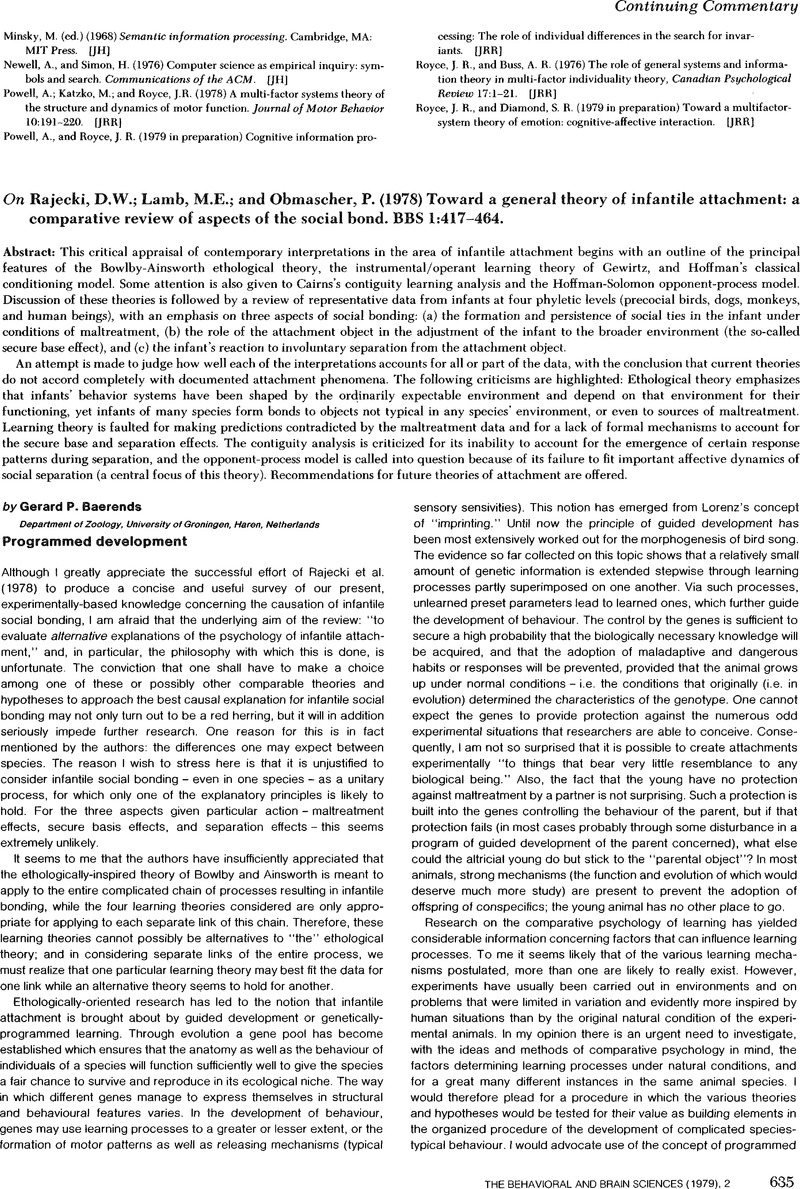Crossref Citations
This article has been cited by the following publications. This list is generated based on data provided by Crossref.
Hibel, Leah C.
Granger, Douglas A.
Blair, Clancy
and
Cox, Martha J.
2011.
Maternal sensitivity buffers the adrenocortical implications of intimate partner violence exposure during early childhood.
Development and Psychopathology,
Vol. 23,
Issue. 2,
p.
689.
Meredith, Pamela
Strong, Jenny
Ford, Pauline
and
Branjerdporn, Grace
2016.
Associations between adult attachment and: oral health-related quality of life, oral health behaviour, and self-rated oral health.
Quality of Life Research,
Vol. 25,
Issue. 2,
p.
423.
Wu, Lili
Gu, Ruolei
and
Zhang, Jianxin
2016.
Attachment affects social information processing: Specific electrophysiological effects of maternal stimuli.
Social Neuroscience,
Vol. 11,
Issue. 3,
p.
317.
Hung, Hsiu‐Yu
and
Lu, Hao‐Te
2018.
The rosy side and the blue side of emotional brand attachment.
Journal of Consumer Behaviour,
Vol. 17,
Issue. 3,
p.
302.
Shimul, Anwar Sadat
and
Phau, Ian
2018.
Consumer Advocacy for Luxury Brands.
Australasian Marketing Journal,
Vol. 26,
Issue. 3,
p.
264.
Rief, Winfried
and
Strauß, Bernhard
2018.
Integratives Störungsmodell als Grundlage der Therapieplanung.
Psychotherapeut,
Vol. 63,
Issue. 5,
p.
401.
Muise, Amy
Maxwell, Jessica A.
and
Impett, Emily A.
2018.
What Theories and Methods From Relationship Research Can Contribute to Sex Research.
The Journal of Sex Research,
Vol. 55,
Issue. 4-5,
p.
540.
Virtanen, T. E.
Pakarinen, E.
Lerkkanen, M.-K.
Poikkeus, A.-M.
Siekkinen, M.
and
Nurmi, J.-E.
2018.
A Validation Study of Classroom Assessment Scoring System–Secondary in the Finnish School Context.
The Journal of Early Adolescence,
Vol. 38,
Issue. 6,
p.
849.
Guay, Frederic
Stupnisky, Robert
Boivin, Michel
Japel, Christa
and
Dionne, Ginette
2019.
Teachers’ relatedness with students as a predictor of students’ intrinsic motivation, self-concept, and reading achievement.
Early Childhood Research Quarterly,
Vol. 48,
Issue. ,
p.
215.
ÜNÜBOL, Hüseyin
and
YILMAZER KAYA, Meryem Büşra
2019.
An examination of the relationship between alexithymia and somatic complaints of mothers and obsessive-compulsive features of children.
Journal of Contemporary Medicine,
Vol. 9,
Issue. 2,
p.
128.
Shuper-Engelhard, Einat
2019.
Ghosts in the Bedroom: Embodiment Wishes in Couple Sexuality: Qualitative Research and Practical Application.
American Journal of Dance Therapy,
Vol. 41,
Issue. 2,
p.
302.
Guzmán-González, Mónica
Wlodarczyk, Anna
Contreras, Paula
Rivera-Ottenberger, Diana
and
Garrido, Lusmenia
2019.
Romantic Attachment and Adjustment to Separation: The Role of Forgiveness of the Former Partner.
Journal of Child and Family Studies,
Vol. 28,
Issue. 11,
p.
3011.
Virtanen, Tuomo Erkki
Vaaland, Grete Sørensen
and
Ertesvåg, Sigrun Karin
2019.
Associations between observed patterns of classroom interactions and teacher wellbeing in lower secondary school.
Teaching and Teacher Education,
Vol. 77,
Issue. ,
p.
240.
Lan, Xiaoyu
and
Radin, Rendy
2020.
Direct and Interactive Effects of Peer Attachment and Grit on Mitigating Problem Behaviors Among Urban Left-Behind Adolescents.
Journal of Child and Family Studies,
Vol. 29,
Issue. 1,
p.
250.
Macfarlane, Jan
2020.
Positive psychology: social connectivity and its role within mental health nursing.
British Journal of Mental Health Nursing,
Vol. 9,
Issue. 2,
p.
1.
Skarstein, S.
Bergem, A. K.
and
Helseth, S.
2020.
How do mothers of adolescents with chronic pain experience their own quality of life?.
BMC Psychology,
Vol. 8,
Issue. 1,
Lan, Xiaoyu
and
Wang, Wenchao
2020.
To be Shy or avoidant? Exploring the longitudinal association between attachment and depressive symptoms among left-behind adolescents in rural China.
Personality and Individual Differences,
Vol. 155,
Issue. ,
p.
109634.
Guzmán-González, Mónica
Contreras, Paula
and
Casu, Giulia
2020.
Romantic attachment, unforgiveness and relationship satisfaction in couples: A dyadic mediation analysis.
Journal of Social and Personal Relationships,
Vol. 37,
Issue. 10-11,
p.
2822.
Guzmán-González, Mónica
Barrientos, Jaime
Gómez, Fabiola
Meyer, Ilan H.
Bahamondes, Joaquín
and
Cárdenas, Manuel
2020.
Romantic Attachment and Relationship Satisfaction in Gay Men and Lesbians in Chile.
The Journal of Sex Research,
Vol. 57,
Issue. 8,
p.
1026.
Karayağız, Şaban
Aktan, Timuçin
and
Karayağız, Lider Zeynep
2020.
Parental Attachment Patterns in Mothers of Children with Anxiety Disorder.
Children,
Vol. 7,
Issue. 5,
p.
46.



